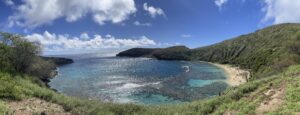By Christopher Wada
Managing water resources requires an understanding of the linkages between key hydrologic factors and direct human influences. The problem is further complicated by the fact that water resources are often interdependent, which suggests that management should also account for ecological interlinkages. For example, a forested upstream watershed may replenish an underlying groundwater aquifer, or a coastal groundwater aquifer may provide positive spillover effects to a downstream nearshore resource such as a fishery. Left unregulated, these spillover effects are economic externalities—additional, unintentional costs or benefits. In general when private parties act in their self-interest in the presence of externalities, the outcome may not be the best for society.
The Kukio Region: Groundwater and Limu
In an application to the Kukio region on the Big Island, Pongkijvorasin et al. (2010) explore how the relationship between submarine groundwater discharge (SGD) and a keystone algal species, Gracilaria coronopifolio (“limu”), in the nearshore affects optimal water management. Lab experiments suggest that moderate levels of SGD influx to a coastal marine environment increase the growth rate of limu due to resulting changes in nutrient loads, temperature and salinity (Duarte et al., 2010). A reduction in the aquifer, and hence SGD, generates a negative externality since there is less water entering the coastal environment. This study shows that optimal water management before accounting for the limu involves only slightly higher water pumping rates (roughly 6 million per year over 100 years in both cases) because the market value of algae is relatively small compared to the benefits of water consumption. However, the market value of limu does not include ecological and cultural values. One way to account for values that are difficult to monetize is a minimum algae-level constraint. If the stock of limu is constrained to be no less than 90% of its current level, the effect on optimal extraction rates is much more dramatic: extraction starts at approximately 4 million per year, falls to 3 million annually by year ten, and stabilizes at less than 0.5 million per year from year 22 onward.
Incentivizing Externalities
Once we understand how optimal resource extraction rates change in the presence of an externality, the next question is how do we internalize it? In other words, what can we do to incentivize private actors (e.g. water consumers) to behave in a way that provides the most benefits to society? When the externality is negative, as is the case where reducing the groundwater stock slows limu growth in the nearshore, a corrective tax can be implemented to reduce groundwater extraction and increase the benefit of higher groundwater levels over a longer period of time. When the externality is positive, as is the case when watershed conservation activities increase recharge for a downstream aquifer, the socially optimal level of conservation can be incentivized using payments or subsidies. As the number of positive and negative externalities within a water management system increases, so does the complexity of the optimal tax/subsidy formula. Nevertheless, advancing methods for managing linked natural systems is important, especially in the context of water resources, given trends of increasing scarcity worldwide and the expected effects of climate change.
BLOG POSTS ARE PRELIMINARY MATERIALS CIRCULATED TO STIMULATE DISCUSSION AND CRITICAL COMMENT. THE VIEWS EXPRESSED ARE THOSE OF THE INDIVIDUAL AUTHORS. WHILE BLOG POSTS BENEFIT FROM ACTIVE UHERO DISCUSSION, THEY HAVE NOT UNDERGONE FORMAL ACADEMIC PEER REVIEW.
References:
Duarte, T.K., Pongkijvorasin, S., Roumasset, J., Amato, D. and K. Burnett (2010), ‘Optimal management of a Hawaiian Coastal aquifer with nearshore marine ecological interactions’, Water Resources Research, 46, W11545.
Pongkijvorasin, S., J. Roumasset, T.K. Duarte and K. Burnett (2010), ‘Renewable resource management with stock externalities: Coastal aquifers and submarine groundwater discharge’,Resource and Energy Economics, 32, 277-291.





